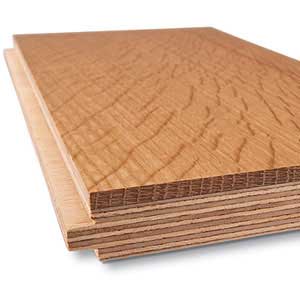Engineered Hardwood Flooring
Warwick | Cranston | North Kingstown | East Greenwich | Providence | Attleboro | Taunton | Fall River
Serving Rhode Island & Southern Massachusetts
 Engineered hardwood flooring remains a popular choice for homeowners who want the look and feel of real wood planks and boards in any room of their house. One of the benefits of engineered hardwood flooring installation is that it is quickly installed over a wide variety of sub flooring types. Also, it tends to be less expensive than non-manufactured options. This creates an excellent value because, depending on the product chosen, it can last from 25 to 100 years in the home.
Engineered hardwood flooring remains a popular choice for homeowners who want the look and feel of real wood planks and boards in any room of their house. One of the benefits of engineered hardwood flooring installation is that it is quickly installed over a wide variety of sub flooring types. Also, it tends to be less expensive than non-manufactured options. This creates an excellent value because, depending on the product chosen, it can last from 25 to 100 years in the home.
What is Engineered Wood Flooring?
Instead of one solid piece of wood, engineered boards use multiple layers of different materials to increase durability and prevent damage from warping, shrinking, or expanding. This makes it an excellent option in locations that have wide temperature and humidity ranges. Also, engineered boards are built with tongue and groove edges so they fit together securely.
The top surface that is seen and walked on every day is always top-quality hardwood. In the industry, this is called the wear layer and comes in a variety of thicknesses. The thicker veneers can even be sanded down and stripped to refinish the floor just as you would natural boards.
Almost every type of wood, grain style, board width and length, and stain color or finish is available in engineered hardwood flooring. The individual pieces that are installed can incorporate one or up to three boards attached together. Narrower plank styles fixed to a wider sub layer make it easier and quicker to install.
There are multiple engineered hardwood flooring installation options available, but engineered hardwood flooring glue down installation is one of the most common used. Just as it sounds, the boards are attached to the sub floor with wood glue. This is an ideal solution for cement, wood, or even vinyl-covered sub floors. If the material is flat, smooth, and at an appropriate humidity level, glue down method for engineered hardwood flooring installation may be the best choice.
On the other hand, many contractors or homeowners opt to install floating hardwood floors instead. Instead of being glued, stapled, or nailed securely to the subfloor, the carefully fitted boards float over it on an underlayment pad.
Get a Free Engineered Hardwood Flooring Estimate Now
Leave us your information, and we will call you back
Floating Engineered Hardwood Floors
After the subfloor is clean, dry, and leveled, a pad or barrier of some type is laid down and attached to it. These come in multiple types, but they are all intended to stop water damage to the subfloor and help stifle sound or movement of the boards that are not actually affixed to the plywood or cement below them. These are not thick or springy like carpet padding because that would make the floating hardwood floor installation very difficult. The finished floor would shift and not be pleasant to walk on.
Floating hardwood floor installation also uses industrial-grade wood adhesives, but it is not used to attach the boards to the barrier or the sub floor itself. Instead, the professional installer runs a bead of glue on the tongue and groove edges of each board. Any excess that squeezes out of the crack between boards is wiped off before it dries, which leaves a perfectly smooth and tight-fitting floor.
Although it may seem that this type of floating floor could shift or become damaged more easily, it may be a better choice for some homes. The process is quicker than the glue down method of engineered hardwood flooring installation. Also, if some boards on the floor do become damaged and need to be replaced, it is much easier to remove them if they are not affixed to the sub floor.
If floorboards are glued or nailed to the sub floor, their movement and position are affected by it. This means that humidity and temperature changes, and the natural shifting that occurs in any house, can expand and contract the sub floor and warp or move the boards away from each other.
With a floating floor, the engineered boards are attached to each other instead. This causes the entire collection of boards to work as one single floor and expand or contract itself. If proper margins are left at the perimeters of the room, neatly hidden under molding or trim, the floor can change without any gaps or warping.
Back to Hardwood Floor InstallationEngineered Hardwood Flooring in Rhode Island & Southern Massachusetts
Serving Clients in the Greater Rhode Island and Southern Massachusetts Areas
